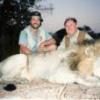-
Content Count
2,887 -
Joined
-
Last visited
-
Days Won
23
Posts posted by billrquimby
-
-
If the truth were known, there are no "wild" horses or burros in North America. All free-roaming horses without owners are feral and have domesticated ancestors somewhere in their family history. It doesn't matter, though. Americans will not accept management by lethal means. That battle was lost in the 1970s, thanks to an activist who called herself "Wild Horse Annie." Much has been written about her, and some of it wound up in movies and books.
Bill Quimby
Bill Quimby
-
 3
3
-
-
"Last time I checked, the hunting of feral animals is not regulated by federal or state law."
Feral horses are protected by the federal Wild Horse and Burro Act of 1971. Penalties for shooting or harassing one on federal land can include a year in prison.
Bill Quimby
-
Brandy's letter tells me she deserves a full scholarship to the university of her choice. She writes clearly and skillfully, and I see great things in her future.
Bill Quimby
-
 3
3
-
-
The two little guys and their mother were in the meadow across the road from the Greer fire station about 7 p.m. this evening when Jean and I pulled over and joined the other gawkers in admiring them.
Bill Quimby
-
 3
3
-
-
You mentioned you hunted on a deBeers property. Was it the Rooipoort Estate near Kimberley? I did a lot of hunting there with friends and without a PH during the 1980s.
Bill Quimby
-
There used to be a gazebo-like structure on the very top, but it was rotting away the last time I saw it. I'm almost certain Baldy's peak is off-limits to non-tribal members now. There's a site a short distance away that is of archeological interest because of the number of tiny beads found there. It is unbelievable to me how early people with virtually no tools could drill such tiny holes and shape such small pieces of rocks.
Bill Quimby
-
Can you still ride to the lookout? The last time I rode up there was in about 1968-69. Since then someone said the Apaches had closed the last part of the trail.
Bill Quimby
-
I found most of the skeleton of a bull hung up on a fence that went across the side of a slope years ago. Rodents had eaten much of one antler, so I left it as I found it. This was way back when we could hunt the White Mountain Apache Reservation for just $25 above the cost of the regular tag.
In my book, "60 Years A Hunter," I told of finding two deer hung up in fences and still alive. The Texas whitetail buck died (from stress, we assumed) after a friend and I worked a half hour and freed it. Coyotes had chewed on the rump and pulled out some intestines on the mule deer doe we found on the Kaibab.
Bill Quimby
-
"Remember the road is now paved all the way to Big Lake from both Springerville and Alpine routes"
It's also paved from Sunrise Lake.
Bill Quimby
-
There seems to be a lot of good info there but I'm having trou b l e s t a y i n g a w a k e zzzzzzzzzzzzzzzzzzz.
Bill Quimby
-
 1
1
-
-
These are great actions. I used one to build a 7mm Remington Magnum I used on everything up to eland and moose. Installing a Model 70-type safety makes them as good as it gets.
Bill Quimby
-
Sorry I left you hanging. We're looking for a matching pair of medium-size concrete pots to mount on the rock-covered posts of the gate at our cabin. Hope you find a buyer.
Bill Quimby
-
Profanity is the crutch of a conversational cripple. ~ Jay Alexander
Twas but my tongue, 'twas not my soul that swore. -- EuripidesTake not God's name in vain; select a time when it will have effect. -- Ambrose BierceAccording to the website "cuss control" Swearing is bad for the following reasons:
Swearing Imposes a Personal Penalty
It gives a bad impression
It makes you unpleasant to be with
It endangers your relationships
It's a tool for whiners and complainers
It reduces respect people have for you
It shows you don't have control
It's a sign of a bad attitude
It discloses a lack of character
It's immature
It reflects ignorance
It sets a bad example
Swearing is Bad for Society
It contributes to the decline of civility
It represents the dumbing down of America
It offends more people than you think
It makes others uncomfortable
It is disrespectful of others
It turns discussions into arguments
It can be a sign of hostility
It can lead to violence
Swearing corrupts the English languageIt's abrasive, lazy language
It doesn't communicate clearly
It neglects more meaningful words
It lacks imagination
It has lost its effectivenessHunt is a four-letter word.-- Bill Quimby-
 8
8
-
-
"Guess what I'm curious about is do the deer know the county boundaries? If you're hunting D16, you're essentially hunting an area that 4 supposed deer subspecies converge. "Pacific Hybrid" is probably the best way I've heard them described. Not knocking anyone, I'm honestly curious how these different subspecies are assigned. Can anyone list out identifying characteristics between a California, Southern, Desert, Peninsular, etc. Mule Deer? Or are the only differences apparent in a blood test."
The short answer is yes, someone can list identifying characteristics of those subspecies, but not me without some research. I'm an author/editor (not a scientist) who was fortunate to have hunted or observed a couple dozen different types of deer on five continents (six, if I counted a hog deer from Pakistan I spent a couple of hours watching on a hunting estate in South Africa), and I read a lot of popular and scientific literature because I have a great interest in knowing more about the world's many big game animals.
I do know differences between subspecies develop over eons as animals adapt to the needs of their specific habitats. These differences are not always quickly visible to most of us. One of the differences between a California mule deer and a Columbia blacktail, for example, is the size and presence of certain scent glands on their legs. With other animals, it may be average measurements of certain bones in their skulls or wherever. Differences in antler shape, body size and coloration that are important to hunters may or may not be important to a taxonomist.
As you mentioned, when the boundaries of subspecies merge, these differences are blurred. There is nothing wrong with hunters creating a record book category that lumps multiple subspecies if it reduces confusion and makes sense to hunters. Boundaries are arbitrary anyway. If a boundary is set along a highway or a river or the top of a mountain range, the same deer might be called a Rocky Mountain mule deer on one side in the morning and a California mule deer on the other in the afternoon. A line has to be drawn somewhere, though.
Record books are tools and history books created by hunters for hunters and can be enlightening and fun to read, but taxonomy is a science and taxonomists take what they do, which is classifying living organisms, seriously.
I find it v-e-r-y interesting that not all of them agree.
Bill Quimby
-
 2
2
-
-
If that lake is near San Diego, which I think it is, chances are very good that the deer you were seeing were southern mule deer. Below is something I found on the 'Net.
Columbian black-tailed deer are the most populous subspecies of deer in California. Habitat ranges from the coastal mountains of Oregon to near Santa Barbara, within the western slope of the Cascade-Sierra Nevada range and along the Sierra Nevada Foothills.
California mule deer are found along the west slope of the Sierra Nevada mountains. They are second most populous.
Rocky Mountain mule deer rank third in population and are the largest mule deer subspecies in California. They are found in Lassen, Shasta, Siskiyou and Modoc counties.
Southern mule deer are found in Orange, Riverside and San Diego Counties.
Inyo mule deer are found in Inyo, Kern and Mono counties.
Desert mule deer are found in Imperial, Riverside and San Bernardino counties as well as SW and southern Arizona and northern Sonora, Mexico.
Bill Quimby
-
Guys:
Many “experts” and the revered reference work “Mammal Species of the World” will say there are ten subspecies of mule deer (Odocoileus heminonus), and divide these ten into two “groups.”
Mule deer group:
Rocky Mountain mule deer (O.h. hemionus) Western and central North America
Inyo mule deer (O.h. inyoensis) California, Sierra NevadaCalifornia mule deer (O.h. californicus)
Desert mule deer (O.h. eremicus) Lower Colorado River; NW Mexico, SE California, Arizona
Southern mule deer (O.h. fuliginatus) southernmost California and Baja California
Cedros/Cerros Island mule deer (O.h. cerrosensis)
Peninsula mule deer (O.h. peninsulae) Baja California Sur
Tiburon Island mule deer (O.h. sheldoni) Tiburon Island
Black-tailed deer group:
Columbia black-tailed deer (O.h. columbianus) Pacific NW, Northern California
Sitka black-tailed deer (O.h. sitkensis) coastal area and islands off British Columbia, Alaska
Others lump the Inyo, Cedros Island and Tiburon Island subspecies with desert mule deer or the Peninsula mule deer, reducing the list to just seven subspecies. A very few also will expand the above list to eleven by including a desert subspecies called O.h. crooki before most taxonomists declared it an “invalid” race. Even fewer will say all subspecies are invalid and say all are simply "mule deer."
At any rate, depending upon the “expert,” California is generally recognized as having from five to six mule deer subspecies (including the Columbia blacktail). Some record books will reduce that to just three or four by lumping subspecies.When I was the SCI record book’s editor many years ago, the record book committee lumped multiple subspecies when there were too few entries to create a separate category for each. The California Bowmen apparently did just that by creating a category in its record book that it calls "Pacific Hybrid." There is no such subspecies, of course.
Incidentally, being small and having a black tail does not necessarily mean a deer in California is a “Columbia blacktail” because many California mule deer also have these features.Bill Quimby
-
 1
1
-
-
Are the two small ones on the right in the photo, and are they a pair?
Bill Quimby
-
Diameter at top?
Diameter at bottom?
Height?
Can't see by the photos if there are designs or other colors on the pots. From what I can see in the shaded area, I'm guessing the basic color is terra cota.
Bill Quimby
-
I spent nearly 30 years working for a daily newspaper and have never seen such non-news published until now. The photo falls into the same category. The Independent's editor should have told that reporter to come back when he/she had a story.
Bill Quimby
-
 4
4
-
-
IA Born:
I know about the muntjacs, musk deer, mouse deer and water deer of Asia and the Philippines. As with elk/red deer, both roe deer species also have "ivories." Next time you're near a mount of a moose, elk, mule deer or whitetail, look closely at the dark spot on each side of its lower jaw. Most of the deer in the world today (except reindeer and caribou) have these spots. I'm convinced these also are vestiges of the fangs of their ancestors. When they lost their long "eye teeth," they retained the dark areas where their fangs once were.
Bill Quimby
-
 1
1
-
-
"Can we get back to discussing rambilly ewenanny AudadBarbary SheepRams?"
Those who deny evolution need only to study this thread to see how natural selection resulted in the aoudad evolving into a peccary.
I think it's time to mention that early Cervids (deer) had fangs and some may have been carnivorous predators. We could start a pool to see how long it will be before someone says deer, wolves, jaguars and bears are closely related.

Bill Quimby
-
 3
3
-
-
"Pretty sure Jerry Day said their closely related to rodents."
I doubt that, unless he was misunderstood when he MIGHT have said something about peccaries having a remote ancestor that somewhere very, very far back in prehistory MAY have gone separate ways with one group evolving into peccaries and others becoming rodents. I don't know if he said that, or even if such a thing happened, but if it did and he did I'm certain he would be the first to say that does not mean they are closely related.
I know Jerry, and saw him at a funeral for a mutual friend recently. If you were to ask him about the peccary/rodent myth, he would say something similar to what Benbrown just said: Rodentia and ungulates are in no way closely related.
Bill Quimby
-
 2
2
-
-
IA: You and I are of similar mind. I introduced this thread to get others thinking about this nifty animal so they would learn more about it. I really don't care whether someone calls the aoudad a sheep or a goat unless he's a client and I'm helping write his memoirs. If my name is connected to his book, however, he shot aoudad billys not rams.
Incidentally, IA, the SCI record book views the elk/wapiti of North America and Asia and the red deer of Eurasia as one species, Cervus elaphus. It has separate categories for trophy measurements based on where the animal was hunted.
Lately, many experts have categorized our elk as Cervus canadensis. I have hunted red deer in New Zealand and Spain, and elk in Mongolia and three U.S. states, and despite obvious differences in their coats, rutting calls, and antler conformation, as a hunter and not a scientist I would say SCI got it right.
Bill Quimby
-
 2
2
-
-
"Have taken several and have been very pleased, and surprised at how good they are. No fat, very lean, a little tough."
It's nice to know the flavor is good. Cooking the toughest meat in a Crock Pot for 10-11 hours or 24 hours in a mesquite-fired pit Mexican style will make it tender.
Bill Quimby



Wild Horses
in Trail Cameras
Posted · Report reply
Beef, pork, turkey, duck and chicken were rationed during World War II, and my mother traded her meat stamps for stamps that allowed her to buy other things (such as gasoline and tires).
As a result, my mother, brother and I ate a lot of horse meat processed for human consumption during the war. (It was on sale in every butcher shop in Yuma.)
I'd forgotten how good it tasted until I was served zebra filets in Zimbabwe in 1983 on my first trip to Africa. I can truthfully say Zebra, horse and burro are delicious!
Bill Quimby